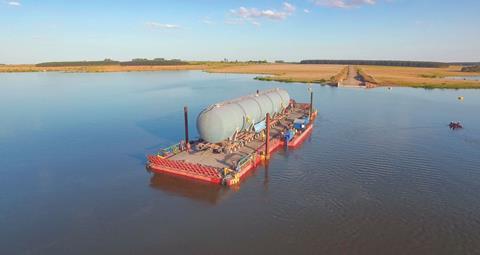deugro has shared details of its role at UPM’s Taurus pulp mill project, which included the delivery of 263,300 freight tons of cargo to the site in Uruguay.

deugro said the project included the delivery of 8,000 containers and 174 oversize pieces, including the highest, widest and heaviest piece moved on Uruguay’s roads.
deugro China, Finland, Germany and Uruguay coordinated planning and execution over 3.5 years, in collaboration with sister company dteq Transport Engineering Solutions. The project included one of the most complex overland transportation concepts ever planned by deugro group, in close cooperation with the Uruguay Ministry of Transport and the client.
UPM had an existing pulp mill in Fray Bentos, Uruguay and decided to invest in a second, larger pulp mill in Paso de los Toros. This production site, located in the central region of Uruguay, went into service in April of this year.
The smaller pieces/containers were shipped from global origins to the port of Montevideo, whereas the oversized cargo was unloaded at Fray Bentos. When the shipments started –mainly from China, Estonia, Finland and Germany – the shipping market was at an all-time high with tonnage limited and costs high.
By combining the breakbulk shipments with containers on the same multipurpose vessels, deugro solved the space issues and avoided extremely high freight charges for the client.
The oversized cargo unloaded at Fray Bentos had to be moved through the existing, active pulp mill. All items were unloaded and stored at a laydown area before being loaded for the 230 km road haul to new mill in central Uruguay. Along that route, 28 bypasses had to be built, cable line masts had to be removed or adjusted, 1,106 traffic signs and pole were removed, 59 overhead objects needed to be cleared, among other preparation.
The main challenge of the road transportation was to bypass a dam. This was executed by developing a customized heavy lift ferry concept with a modular barge. Dedicated transport engineering personnel operated and supervised the barge during operation. The barge crossed the Rio Negro River around 700 times in total to move all the project cargo safely to the other side of the dam at Baygorria Reservoir.
“Our tailor-made barge design was the solution that finally led to obtaining the go-ahead for the whole project, as the dam at Baygorria built the critical link of the entire transportation,” said Franklin Alvarez, regional director transport engineering Americas for dteq. “We designed a modular self-propelled barge fitting the specific needs of the project. It is capable of performing ro-ro operations and is constructed of interlocking pontoons.
dteq secured HLPFI’s Excellence in Engineering award at the 2022 Heavy Lift Awards for its role in the project.
















